Trends in CO2 Emissions from China-Oriented International Marine Transportation Activities and Policy Implications
Abstract
:1. Introduction
2. Literature Review
3. Methodology and Data
3.1. Methodology
3.2. Data Collection and Scenarios Design
3.2.1. Marine Transport Turnover
3.2.2. Energy Intensity
3.2.3. CO2 Emissions Factor
4. Results and Discussion
4.1. Trend of Transport Demand
4.2. Trends of CO2 Emissions in Various Scenarios
4.2.1. BAU Scenario
4.2.2. AD Scenarios
5. Policy Implications in China
5.1. Monitoring and Identifying Measures
5.2. Potential Mitigation Policies
6. Conclusions
Acknowledgments
Author Contributions
Conflicts of Interest
References
- Clarksons Research. August 2015 Seaborne Trade Monitor; Clarksons Research: London, UK, 2015. [Google Scholar]
- International Maritime Organization (IMO). Third IMO GHG Study 2014; IMO: London, UK, June 2014. [Google Scholar]
- Clarksons Research. December 2016 China Intelligence Monthly; Clarksons Research: London, UK, 2016. [Google Scholar]
- Guo, B.; Geng, Y.; Franke, B.; Han, H.; Liu, Y.; Chiu, A. Uncovering China’s transport CO2 emission patterns at the regional level. Energy Policy 2014, 74, 134–146. [Google Scholar] [CrossRef]
- Intergovernmental Panel on Climate Change (IPCC). Climate Change 2014 Synthesis Report; IPCC: Geneva, Switzerland, 2014. [Google Scholar]
- Cioca, L.I.; Ivascu, L.; Rada, E.C.; Torretta, V.; Ionescu, G. Sustainable Development and Technological Impact on CO2 Reducing Conditions in Romania. Sustainability 2015, 7, 1637–1650. [Google Scholar] [CrossRef]
- Dodić, S.N.; Popov, S.D.; Dodić, J.M.; Ranković, J.A.; Zavargo, Z.Z. Potential contribution of bioethanol fuel to the transport sector of Vojvodina. Renew. Sustain. Energy Rev. 2009, 13, 2197–2200. [Google Scholar] [CrossRef]
- Merk, O. Shipping Emissions in Ports. International Transport Forum Discussion Papers; OECD Publishing: Paris, France, 2014. [Google Scholar]
- United Nations Conference on Trade and Development (UNCTAD). Review of Maritime Transport 2016; United Nations: Geneva, Switzerland, 2016. [Google Scholar]
- Guo, J.; Zou, L.L.; Wei, Y.M. Impact of inter-sectoral trade on national and global CO2 emissions: An empirical analysis of China and Us. Energy Policy 2010, 38, 1389–1397. [Google Scholar] [CrossRef]
- IMO. Marine Environment Protection Committee (MEPC), 70th Session, 24–28 October 2016. Available online: http://www.imo.org/en/MediaCentre/SecretaryGeneral/Secretary-GeneralsSpeechesToMeetings/Pages/MEPC-70-opening.aspx (accessed on 27 June 2017).
- Yan, X. Life Cycle Energy Demand and Greenhouse Gas Emissions in Chinas Road Transport Sector: Future Trends and Policy Implications. Ph.D. Thesis, Queen Mary University of London, London, UK, 2008. [Google Scholar]
- Wang, W.W.; Zhang, M.; Zhou, M. Using LMDI method to analyze transport sector CO2, emissions in China. Energy 2011, 36, 5909–5915. [Google Scholar] [CrossRef]
- Cai, B.; Yang, W.; Cao, D.; Liu, L.; Zhou, Y.; Zhang, Z. Estimates of China’s national and regional transport sector CO2 emissions in 2007. Energy Policy 2012, 41, 474–483. [Google Scholar] [CrossRef]
- Wang, Y.F.; Li, K.P.; Xu, X.M.; Zhang, Y.R. Transport energy consumption and saving in China. Renew. Sustain. Energy Rev. 2014, 29, 641–655. [Google Scholar] [CrossRef]
- Liu, Z.; Li, L.; Zhang, Y.J. Investigating the CO2 emission differences among China’s transport sectors and their influencing factors. Nat. Hazards 2015, 77, 1323–1343. [Google Scholar] [CrossRef]
- Hao, H.; Geng, Y.; Li, W.; Guo, B. Energy consumption and GHG emissions from China’s freight transport sector: Scenarios through 2050. Energy Policy 2015, 85, 94–101. [Google Scholar] [CrossRef]
- Hao, H.; Wang, H.; Ouyang, M. Fuel consumption and life cycle GHG emissions by China’s on-road trucks: Future trends through 2050 and evaluation of mitigation measures. Energy Policy 2012, 43, 244–251. [Google Scholar] [CrossRef]
- Hao, H.; Liu, Z.; Zhao, F.; Li, W.; Hang, W. Scenario analysis of energy consumption and greenhouse gas emissions from China’s passenger vehicles. Energy 2015, 91, 151–159. [Google Scholar] [CrossRef]
- Zheng, B.; Zhang, Q.; Borken-Kleefeld, J.; Hong, H.; Guan, D.; Klimont, Z.; Peters, G.P.; He, K. How will greenhouse gas emissions from motor vehicles be constrained in China around 2030? Appl. Energy 2015, 156, 230–240. [Google Scholar] [CrossRef]
- Hao, H.; Mu, Z.; Jiang, S.; Liu, Z.; Zhao, F. GHG Emissions from the Production of Lithium-Ion Batteries for Electric Vehicles in China. Sustainability 2017, 9, 504. [Google Scholar] [CrossRef]
- Lang, J.; Cheng, S.; Zhou, Y.; Zhao, B.; Wang, H.; Zhang, S. Energy and Environmental Implications of Hybrid and Electric Vehicles in China. Energies 2013, 6, 2663–2685. [Google Scholar] [CrossRef]
- Takeshita, T. Global Scenarios of Air Pollutant Emissions from Road Transport through to 2050. Int. J. Environ. Res. Public Health 2011, 8, 3032–3062. [Google Scholar] [CrossRef] [PubMed]
- Wei, Q.; Zhao, S. Estimating CO2 Emission and Mitigation Opportunities of Wanzhou Shipping in Chongqing Municipality, China. In Proceedings of the International Conference on Logistics Engineering and Intelligent Transportation Systems, Miami, FL, USA, 26–28 November 2010; pp. 1–4. [Google Scholar]
- Hao, H.; Geng, Y.; Ou, X. Estimating CO2 emissions from water transportation of freight in China. Int. J. Shipp. Transp. Logist. 2015, 7, 676–694. [Google Scholar] [CrossRef]
- Intergovernmental Panel on Climate Change (IPCC). 2006 IPCC Guidelines for National Greenhouse Gas Inventories; Intergovernmental Panel on Climate Change: Hayama, Japan, 2006. [Google Scholar]
- International Maritime Organization (IMO). Second IMO GHG Study 2009; IMO: London, UK, June 2009. [Google Scholar]
- Psaraftis, H.N.; Kontovas, C.A. CO2 emission statistics for the world commercial fleet. WMU J. Marit. Aff. 2009, 8, 1–25. [Google Scholar] [CrossRef]
- Liu, Q.; Gu, A.; Teng, F.; Song, R.; Chen, Y. Peaking China’s CO2 Emissions: Trends to 2030 and Mitigation Potential. Energies 2017, 10, 209. [Google Scholar] [CrossRef]
- Hatzopoulou, M.; Hao, J.Y.; Miller, E.J. Simulating the impacts of household travel on greenhouse gas emissions, urban air quality, and population exposure. Transportation 2011, 38, 871. [Google Scholar] [CrossRef]
- Kutner, M.H.; Nachtsheim, C.J.; Neter, J. Applied Linear Regression Models, 5th ed.; Technometrics: Alexandria, VA, USA, 2004; Volume 26. [Google Scholar]
- Limanond, T.; Jomnonkwao, S.; Srikaew, A. Projection of future transport energy demand of Thailand. Energy Policy 2011, 39, 2754–2763. [Google Scholar] [CrossRef]
- Ratanavaraha, V.; Jomnonkwao, S. Trends in Thailand CO2 emissions in the transportation sector and policy mitigation. Transp. Policy 2015, 41, 136–146. [Google Scholar] [CrossRef]
- Clarksons Research. March 2017 China Intelligence Monthly; Clarksons Research: London, UK, 2017. [Google Scholar]
- Clarksons Research. September 2013 China Intelligence Monthly; Clarksons Research: London, UK, 2013. [Google Scholar]
- Clarksons Research. December 2011 China Intelligence Monthly; Clarksons Research: London, UK, 2011. [Google Scholar]
- Clarksons Research. June 2008 China Intelligence Monthly; Clarksons Research: London, UK, 2008. [Google Scholar]
- Clarksons Research. Shipping Intelligence Network Time Series; Clarksons Research: London, UK, 2017. [Google Scholar]
- Clarksons Research. January 2017 Seaborne Trade Monitor; Clarksons Research: London, UK, 2017. [Google Scholar]
- National Bureau of Statistics of China (NBSC). China Statistical Yearbook 2016; China Statistics Press: Beijing, China, 2016. [Google Scholar]
- Yin, X.; Chen, W.; Eom, J.; Clarke, L.E.; Kim, S.H.; Patel, P.L.; Yu, S.; Kyle, G.P. China’s transportation energy consumption and CO2 emissions from a global perspective. Energy Policy 2015, 82, 233–248. [Google Scholar] [CrossRef]
- Zhou, N.; Fridley, D.; Khanna, N.Z.; Ke, J.; Mcneil, M.; Levine, M. China’s energy and emissions outlook to 2050: Perspectives from bottom-up energy end-use model. Energy Policy 2013, 53, 51–62. [Google Scholar] [CrossRef]
- Lee, T.C.; Lam, J.S.L.; Lee, T.W. Asian economic integration and maritime CO2 emissions. Transp. Res. D Transp. Environ. 2016, 43, 226–237. [Google Scholar] [CrossRef]
- Harvey, L.D.D. Global climate-oriented transportation scenarios. Energy Policy 2013, 54, 87–103. [Google Scholar] [CrossRef]
- Ruzzenenti, F.; Basosi, R. Evaluation of the energy efficiency evolution in the European road freight transport sector. Energy Policy 2009, 37, 4079–4085. [Google Scholar] [CrossRef]
- Burel, F.; Taccani, R.; Zuliani, N. Improving sustainability of maritime transport through utilization of Liquefied Natural Gas (LNG) for propulsion. Energy 2013, 57, 412–420. [Google Scholar] [CrossRef]
- International Gas Union (IGU). Enabling Clean Maine Transport; IGU: Barcelona, Spain, 2017. [Google Scholar]
- Nelissen, D.; Faber, J.F. Economic Impacts of MRV of Fuel and Emissions in Maritime Transport; CE Delft: Delft, The Netherlands, 2014. [Google Scholar]
- Aldy, J.E.; Pizer, W.A. The Competitiveness Impacts of Climate Change Mitigation Policies; Discussion Paper 2015-73; Harvard Project on Climate Agreements: Cambridge, MA, USA, 2015. [Google Scholar]
- Carl, J.; Fedor, D. Tracking global carbon revenues: A survey of carbon taxes versus cap-and-trade in the real world. Energy Policy 2016, 96, 50–77. [Google Scholar] [CrossRef]
- Goulder, L.H.; Schein, A.R. Carbon taxes versus cap and trade: A critical review. Clim. Chang. Econ. 2013, 4, 1350010. [Google Scholar] [CrossRef]
- Strand, J. Strategic climate policy with offsets and incomplete abatement: Carbon taxes versus cap-and-trade. J. Environ. Econ. Manag. 2013, 66, 202–218. [Google Scholar] [CrossRef]
- Stochniol, A. A New Market-Based CO2 Emission Reduction Scheme; Supporting Document for Discussion of MEPC: London, UK, 2007. [Google Scholar]
- EU Looks to Extend Emissions Tax to International Shipping. Available online: http://dailycaller.com/2012/10/03/eu-looks-to-extend-emissions-tax-to-international-shipping.html (accessed on 15 June 2017).
- Including Maritime Transport Emissions in the EU’s Greenhouse Gas Reduction Commitment. Available online: https://ec.europa.eu/clima/consultations/articles/0014_en (accessed on 14 June 2017).
- Shipping EU ETS Proposal Should Be a Wake-Up Call for IMO? Available online: http://worldmaritimenews.com/archives/214619/shipping-eu-ets-proposal-should-be-a-wake-up-call-for-imo/ (accessed on 18 June 2017).
- Governments Carefully Weigh up Shipping EU ETS. Available online: http://www.green4sea.com/governments-carefully-weigh-up-shipping-eu-ets/ (accessed on 27 June 2017).
- Lin, C.B.; Zhao, D.Q.; Cai, G.T.; Kai-Hon, L.; Ka-Wing, N.G. Greenhouse Gas emissions from cargo vessels and low-carbon shipping strategies in Guangdong province. Res. Environ. Sci. 2013, 26, 1340–1348. (In Chinese) [Google Scholar]
- Lindstad, H.; Asbjørnslett, B.E.; Strømman, A.H. Reductions in greenhouse gas emissions and cost by shipping at lower speeds. Energy Policy 2013, 39, 3456–3464. [Google Scholar] [CrossRef]
- Corbett, J.J.; Wang, H.; Winebrake, J.J. The effectiveness and costs of speed reductions on emissions from international shipping. Transp. Res. D Transp. Environ. 2009, 14, 593–598. [Google Scholar] [CrossRef]
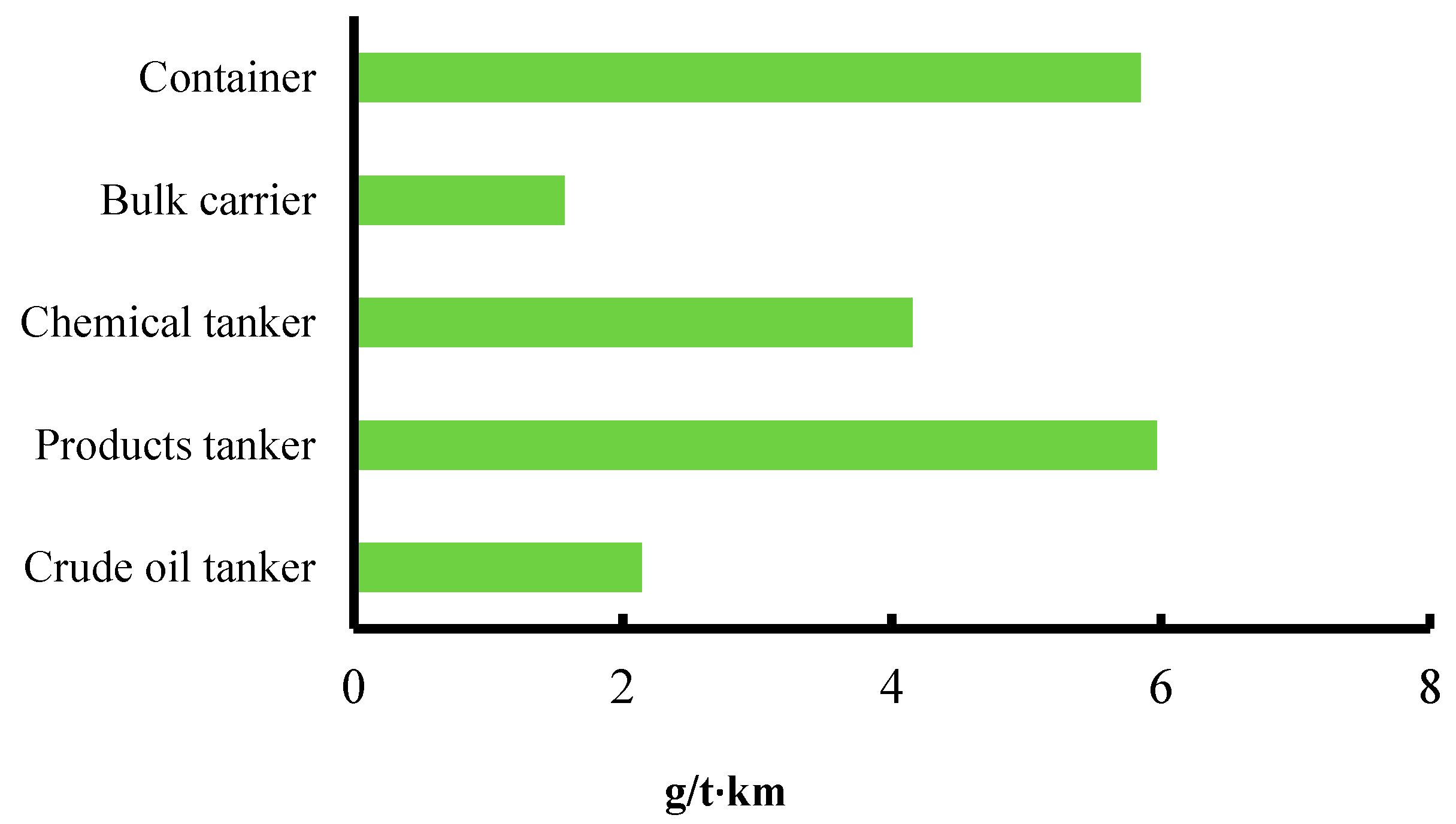
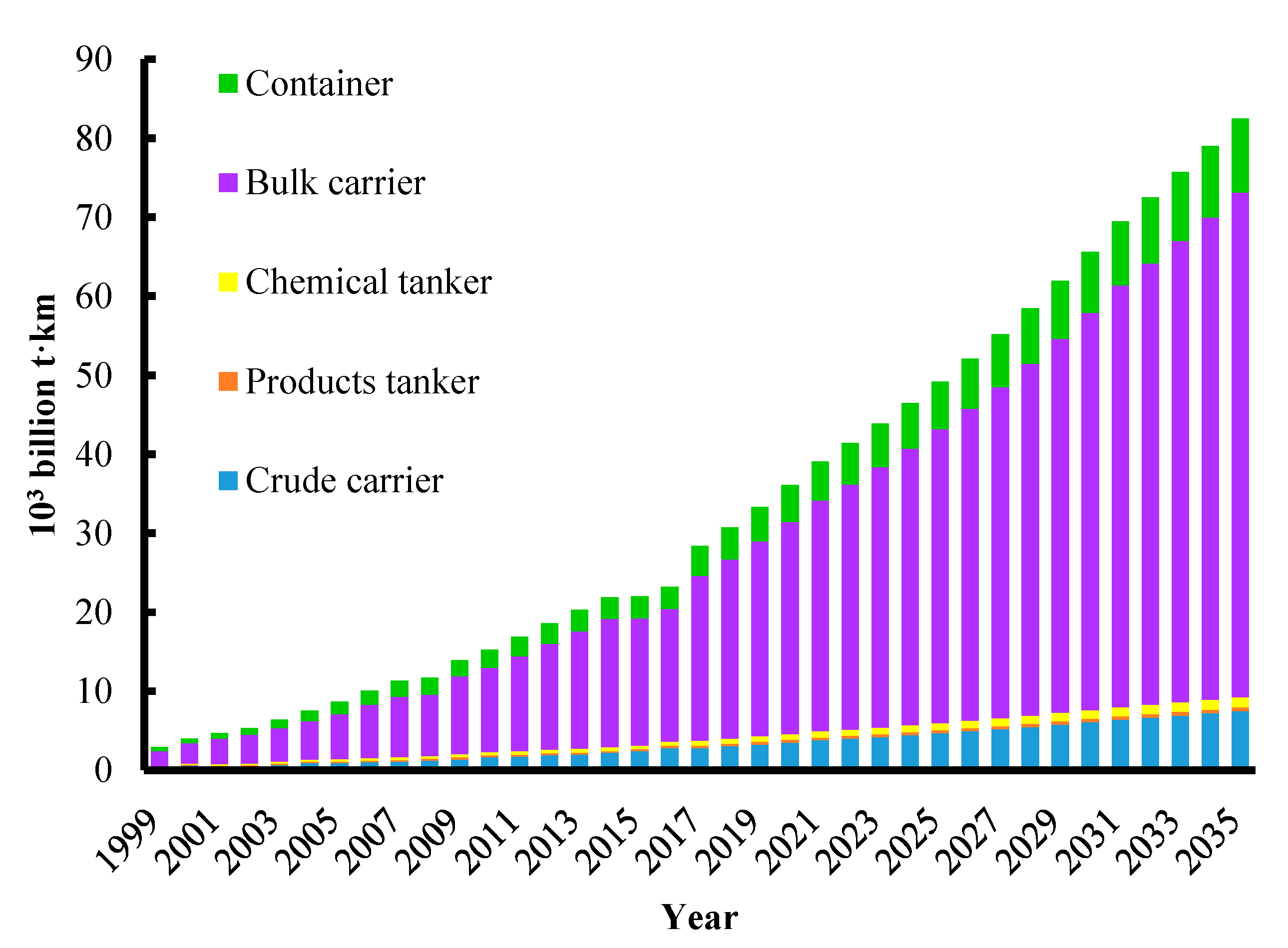
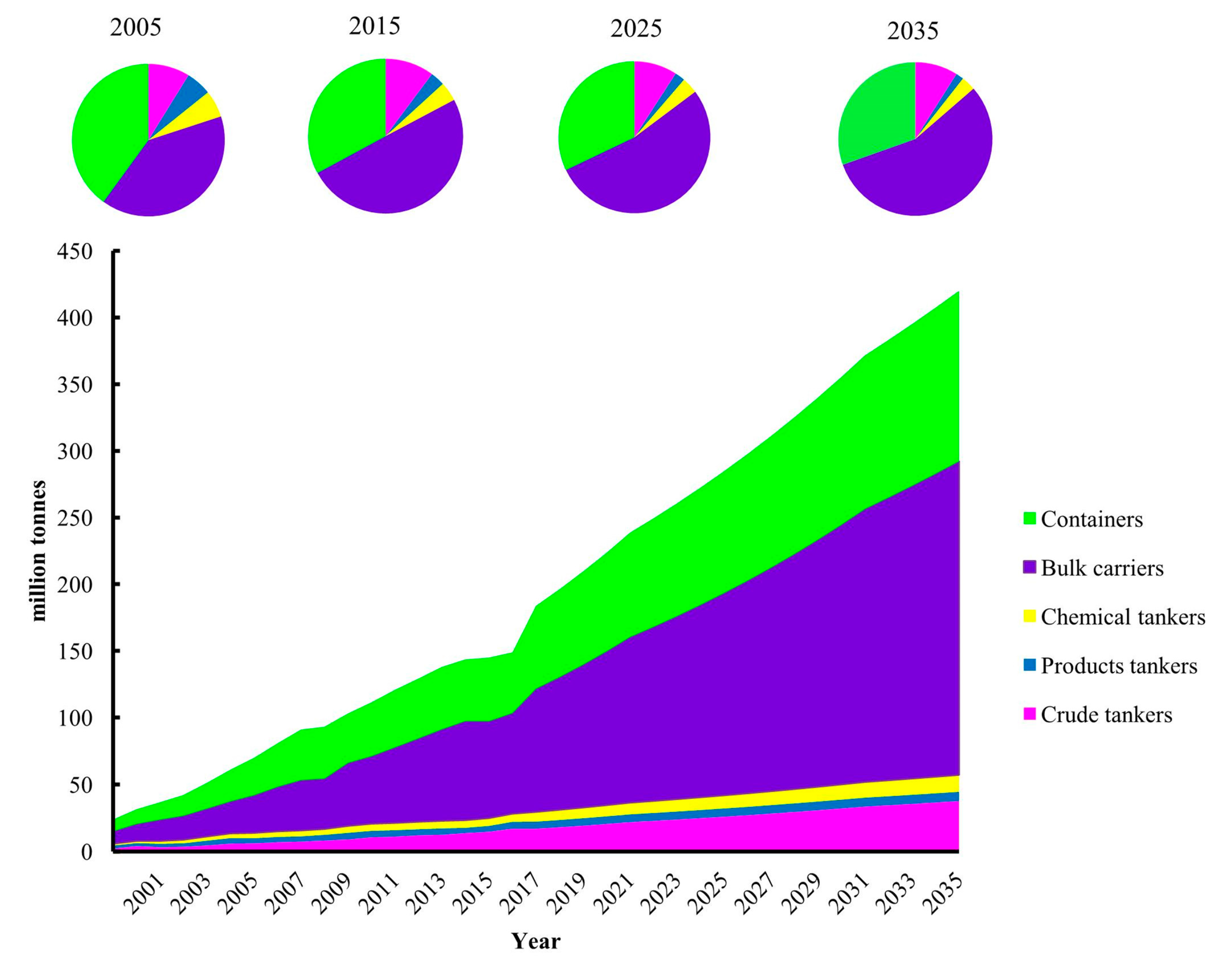
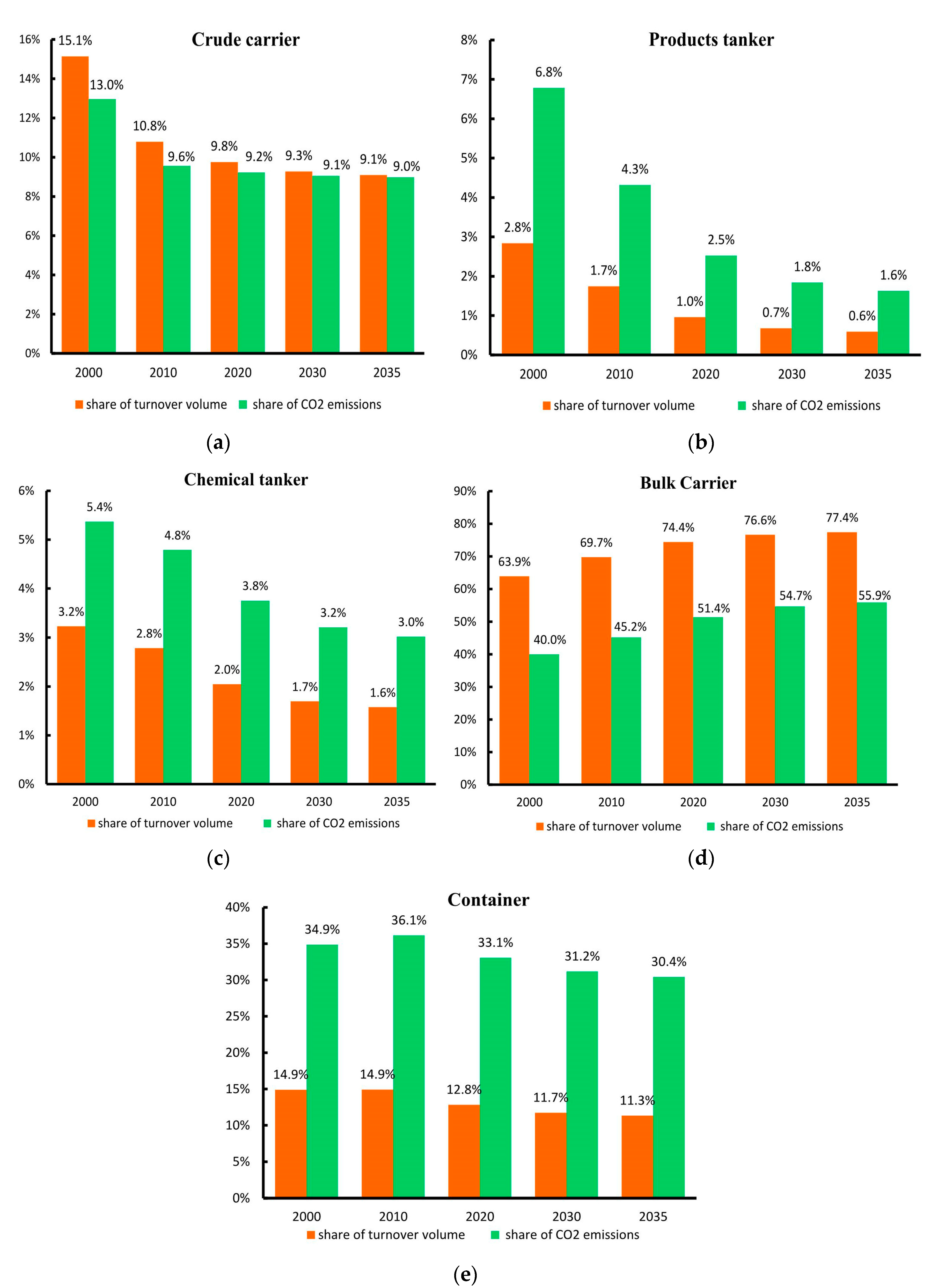
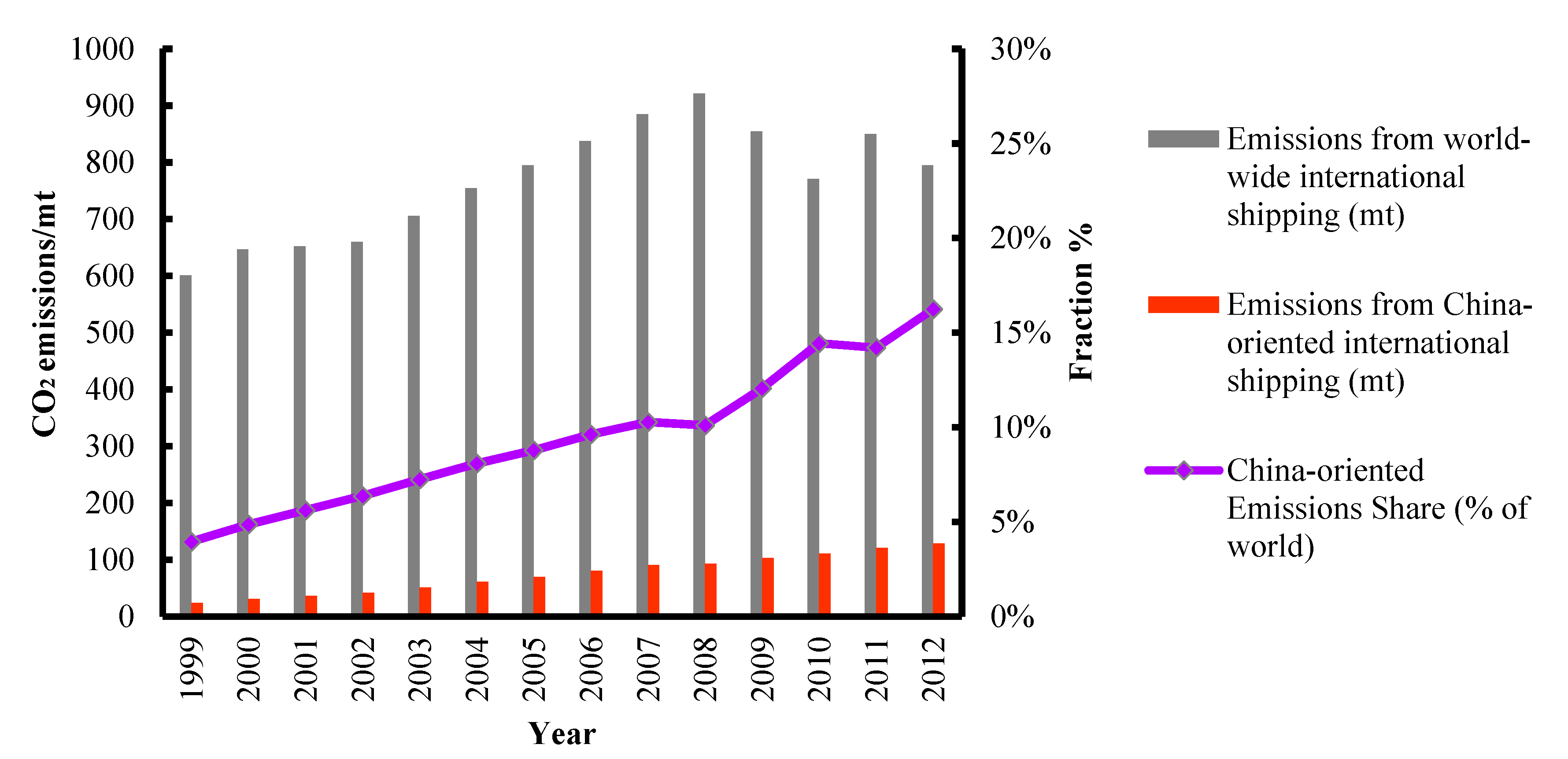
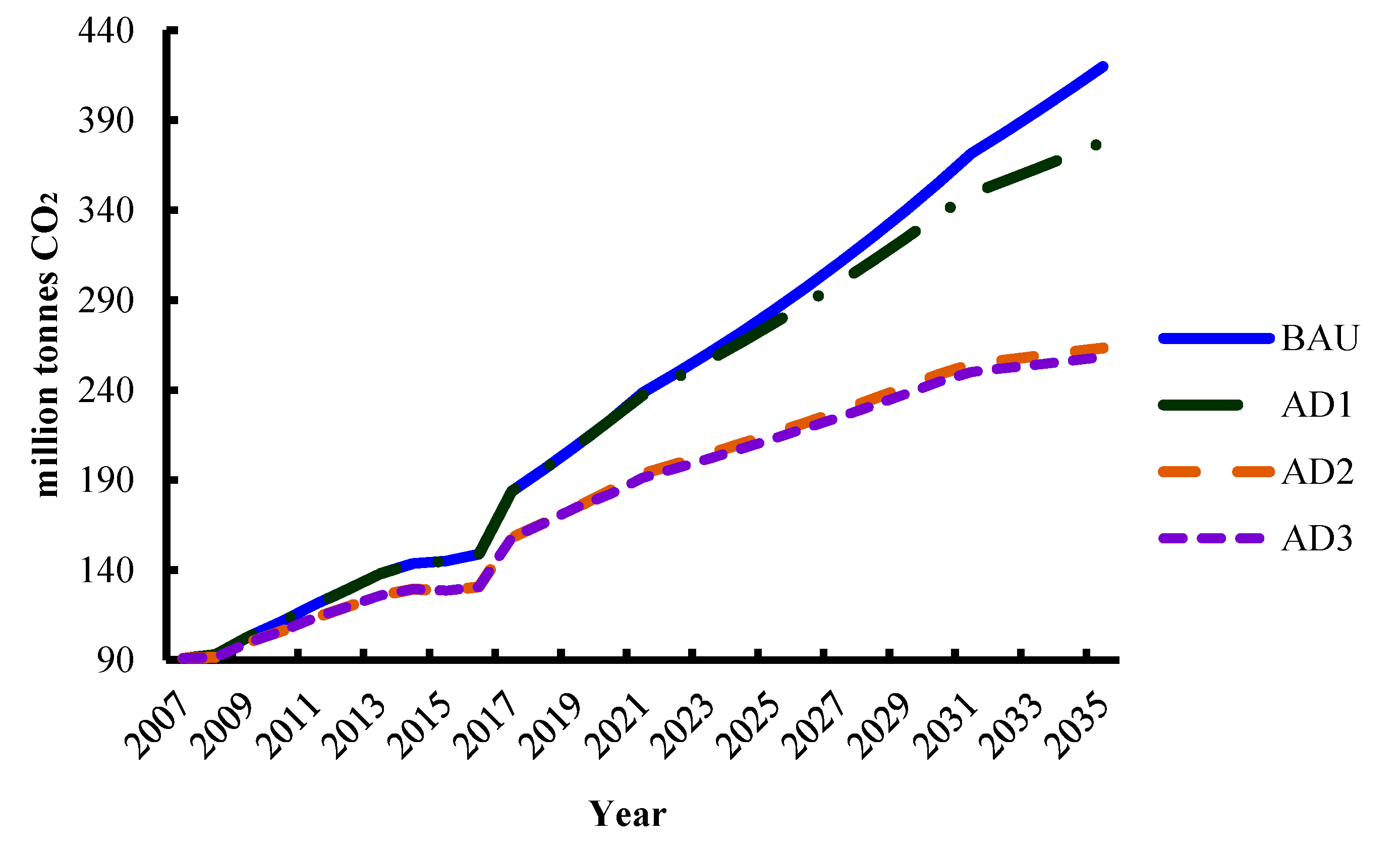
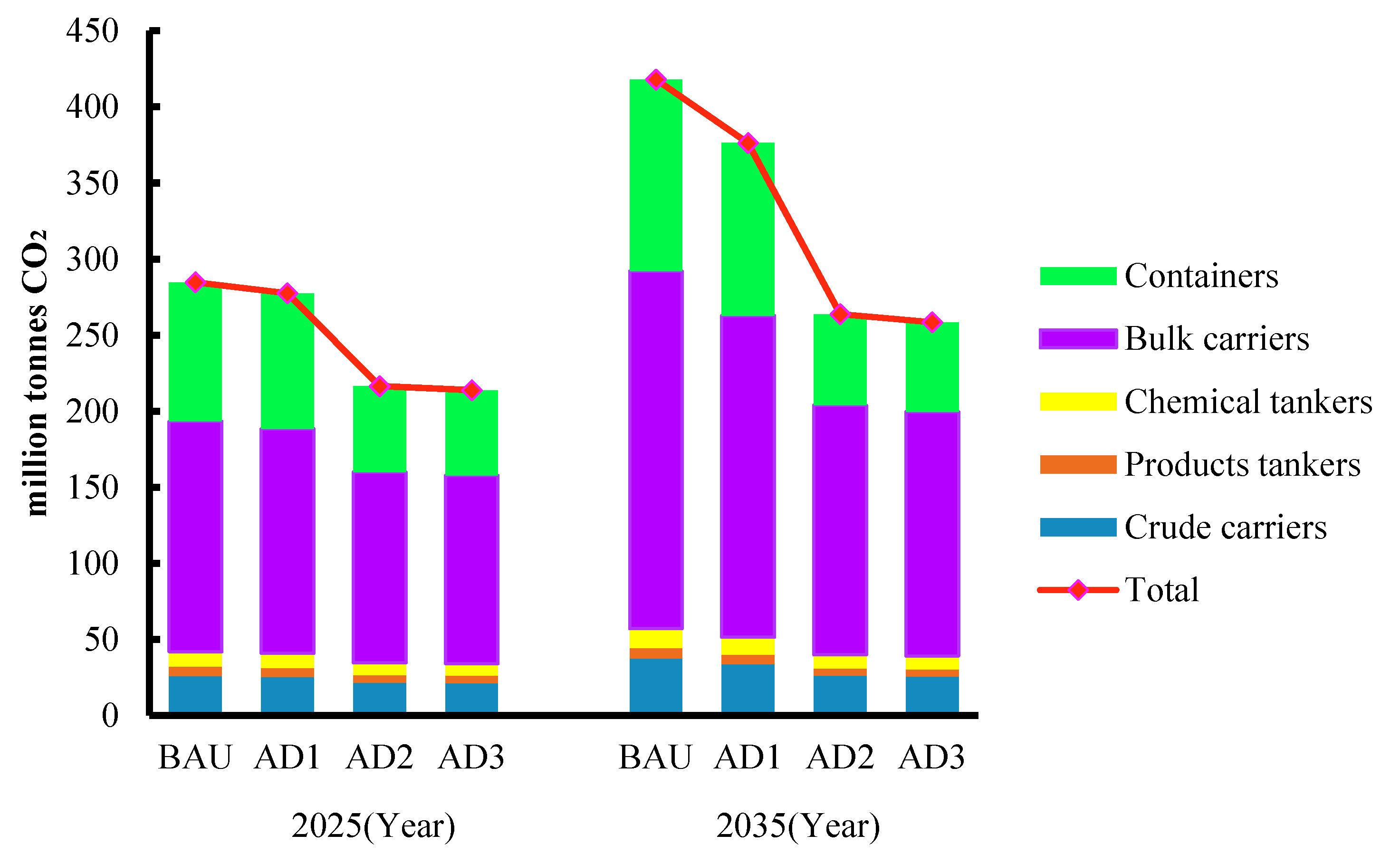
| Scenario | Categories | Energy Intensity Improvements | |
|---|---|---|---|
| 2020 (%) | 2035 (%) | ||
| BAU | Crude oil carrier | −12% | −25% |
| Products tanker | −12% | −25% | |
| Chemical tanker | −12% | −25% | |
| Bulk carrier | −12% | −25% | |
| Container | −12% | −25% | |
| S2 | Crude oil carrier | −22% | −41% |
| Products tanker | −22% | −41% | |
| Chemical tanker | −22% | −41% | |
| Bulk carrier | −22% | −41% | |
| Container | −39% | −61% | |
| Scenario | HFO | LNG | ||||
|---|---|---|---|---|---|---|
| 2020 (%) | 2030 (%) | 2035 (%) | 2020 (%) | 2030 (%) | 2035 (%) | |
| BAU | 100% | 100% | 100% | 0% | 0% | 0% |
| S3 | 90% | 85% | 82.5% | 10% | 15% | 17.5% |
| Scenario | Transport Demand | Energy Efficiency | Fuel Use |
|---|---|---|---|
| BAU | BAU | BAU | BAU |
| AD1 | S1 | BAU | BAU |
| AD2 | S1 | S2 | BAU |
| AD3 | S1 | S2 | S3 |
© 2017 by the authors. Licensee MDPI, Basel, Switzerland. This article is an open access article distributed under the terms and conditions of the Creative Commons Attribution (CC BY) license (http://creativecommons.org/licenses/by/4.0/).
Share and Cite
Yang, H.; Ma, X.; Xing, Y. Trends in CO2 Emissions from China-Oriented International Marine Transportation Activities and Policy Implications. Energies 2017, 10, 980. https://doi.org/10.3390/en10070980
Yang H, Ma X, Xing Y. Trends in CO2 Emissions from China-Oriented International Marine Transportation Activities and Policy Implications. Energies. 2017; 10(7):980. https://doi.org/10.3390/en10070980
Chicago/Turabian StyleYang, Hualong, Xuefei Ma, and Yuwei Xing. 2017. "Trends in CO2 Emissions from China-Oriented International Marine Transportation Activities and Policy Implications" Energies 10, no. 7: 980. https://doi.org/10.3390/en10070980
APA StyleYang, H., Ma, X., & Xing, Y. (2017). Trends in CO2 Emissions from China-Oriented International Marine Transportation Activities and Policy Implications. Energies, 10(7), 980. https://doi.org/10.3390/en10070980




